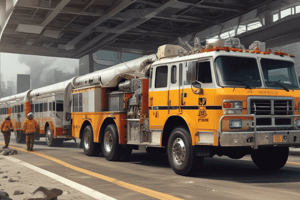Podcast
Questions and Answers
What is one of the primary advantages of using an Incident Management Team (IMT)?
What is one of the primary advantages of using an Incident Management Team (IMT)?
- To take away tactical decisions from the IC
- To allow the Incident Commander to make all decisions alone
- To allow a second person to observe the actions of the IC (correct)
- To assign a Logistics Officer to the IC
What is a primary role of the Safety Officer (SO)?
What is a primary role of the Safety Officer (SO)?
- To take a fresh look at the critical factors on the fireground (correct)
- To fill the roles of Logistics, Planning, Safety, and Finance/Administration
- To deal with the impact of the incident on the community
- To take control of the tactical worksheet
What is the purpose of the SO's evaluation of the fireground tactical and task level organization?
What is the purpose of the SO's evaluation of the fireground tactical and task level organization?
- To ensure the IC is focused on tactics and strategy
- To assign Chief Officers to critical sectors
- To take control of the IC's tactical decisions
- To evaluate the effectiveness of the IAP and make adjustments as needed (correct)
What is the role of the Senior Advisor (SA) in the IMT?
What is the role of the Senior Advisor (SA) in the IMT?
What is the purpose of the SO's control of the tactical worksheet?
What is the purpose of the SO's control of the tactical worksheet?
Why is the SO important to the IMT?
Why is the SO important to the IMT?
What is the role of the IC in the IMT?
What is the role of the IC in the IMT?
What is the purpose of the SA's evaluation of the need for the City EOC?
What is the purpose of the SA's evaluation of the need for the City EOC?
What is the primary role of the FITs in the IMT?
What is the primary role of the FITs in the IMT?
Why is it important for the SA to step away from the IC's and SO's tactical decision making?
Why is it important for the SA to step away from the IC's and SO's tactical decision making?
What is the main characteristic of the Incident Management System (IMS)?
What is the main characteristic of the Incident Management System (IMS)?
How many Command Officers are typically part of an Incident Management Team?
How many Command Officers are typically part of an Incident Management Team?
What is the primary role of the Incident Commander?
What is the primary role of the Incident Commander?
What should the Support Officer do if the Incident Commander cannot provide a valid Incident Action Plan?
What should the Support Officer do if the Incident Commander cannot provide a valid Incident Action Plan?
What is one of the key functions of the Support Officer?
What is one of the key functions of the Support Officer?
What is the purpose of an Incident Management Team?
What is the purpose of an Incident Management Team?
Flashcards are hidden until you start studying
Study Notes
Incident Management System (IMS)
- The IMS is designed to be expandable in response to the size of the emergency incident, allowing it to expand and contract depending on the number of apparatus and level of organization required to manage the incident.
- Each change in organizational level will necessitate some changes in the organizational hierarchy and responsibility.
Incident Management Teams
- An Incident Management Team consists of 2-3 Command Officers, an Incident Commander, a Support Officer, and possibly a Senior Advisor.
- The team is located in a strategic position, usually a Command Vehicle.
- Each Command Officer has specific roles to fill in the team process.
Support Officer (SO)
- The SO is typically an Officer one rank higher than the Incident Commander.
- The SO has seven key functions:
- Refine, evaluate, or change the Incident Action Plan (IAP) if necessary.
- Provide guidance on tactical priorities, fireground factors, and firefighter safety.
- Assign logistics and safety tasks, including assigning a Logistics Officer if necessary.
- Control the tactical worksheet, ensuring accurate management of units and resources.
- Evaluate the fireground tactical and task level organization, including sector assignments and span of control.
- Act as a second set of eyes and ears, utilizing their knowledge and experience.
- Protect the Incident Commander from interruptions, while still providing essential information and communications.
Senior Advisor (SA)
- The SA is typically filled by the Senior Chief Officer.
- The SA's roles include:
- Ensuring Unified Command and business cycle meetings are established.
- Dealing with the impact of the incident on the community, including hazardous materials, long-term effects, and consequences.
- Handling issues that the Incident Commander and Support Officer are not working on.
- Determining if the City EOC is required and informing senior City Officials.
- Filling roles in Logistics, Planning, Safety, and Finance/Administration as needed.
- The SA does not get involved with fireground tactics, preventing Incident Command by committee.
Studying That Suits You
Use AI to generate personalized quizzes and flashcards to suit your learning preferences.



